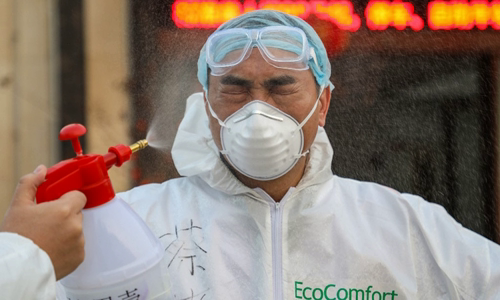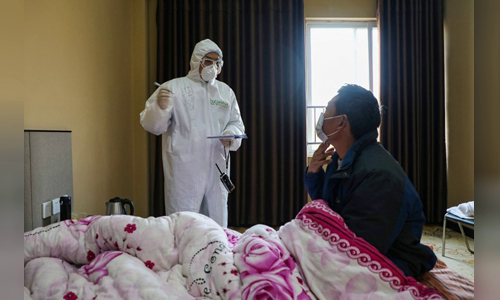China Wuhan corona virus frontline doctors are overwhelmed by the growing number of patients and the high risk of infection due to the lack of protective equipment.
These doctors treat thousands of new corona virus infections every week in Wuhan, the focus city of the Covid-19 outbreak since December last year. Many physicians have to host patients without adequate masks or protective gear, causing them to reuse the equipment that should have been replaced regularly.

A doctor in Wuhan was sprayed with disinfectant colleagues on February 3 Photo: AFP
Wuhan Vice Mayor said last week that the city is in danger of missing 56,000 N95 masks and 41,000 protective suits every day. The medical team wearing protective gear "will wear diapers, reduce water intake and reduce the number of toilet visits," said Jiao Yahui, a top official with China's National Health Commission.
Many of them have to wear a suit for 6-9 hours, despite the fact that they should not wear protective gear for more than 4 hours in an isolated area. "Of course we don't support this method, but the medical team really has no other way," Ms Jiao admitted.
The Chinese government has mobilized the whole country to increase the production of masks and protective gear. On 10/2, 3/4 of the factories producing masks and protective equipment were put back into operation after the Lunar New Year holidays. China has also imported more than 300 million masks and about 3.9 million protective suits since January 24.
"Although we received more masks, the number of patients increased even faster," said an anonymous doctor at a large hospital in Wuhan. According to her, each doctor or nurse uses 2-4 masks each day. "The demand for masks in hospitals is huge. They often lack masks."
Doctors are also forced to wear temporary protective clothing, which is not effective enough against the virus, said 34-year-old Xu Yuan, a Chinese living in the United States. Xu donated $ 5,000 worth of protective equipment to his former classmate who works at hospitals in Wuhan.
"As soon as he wore it, the suit cracked because it was too small," she said, referring to a friend in Wuhan who had to wear a protective outfit for five days. "He disinfects his clothes after use every day. He knows it may be useless, but it is better than nothing."
About 44% of the 42,600 cases of infection and the majority of 1,113 deaths in mainland China are in Wuhan, where the outbreak occurred. According to local health sources, at least 500 doctors at hospitals in Wuhan were infected with the new strain of corona virus as of mid-January.
The Chinese government often reports individual cases of Covid-19 disease, but never gave an overall statistic. The source said doctors and nurses in Wuhan were asked not to disclose this information.

Doctor (left) talks with a male patient in a quarantine area in Wuhan on February 3 Photo: AFP
The risks that Wuhan medical staff faces are attracting more attention after the death of Doctor Ly Van Luong on February 8 due to corona virus infection. The ophthalmologist died more than a month after he and eight others tried to warn of the emergence of a new virus that was like the pandemic SARS (severe acute respiratory syndrome) in 2002-2003.
In the course of treating patients, doctors in Wuhan face another major challenge, the doctor at a large hospital in Wuhan, whose colleague is treating new patients with corona virus, for good.
"They were exhausted," she said. One of her colleagues working at a clinic received 400 patients in just 8 hours. Many of them "die very quickly or cannot be saved".
"They were under a lot of pressure," the doctor said, adding that the hospital where she worked had psychological tests for the doctors.
"Many Wuhan people are also very worried," said a doctor at the community clinic in the city. He and his colleagues received calls from people in distress, many of whom did not dare leave their homes out of fear.
"You can hear their cries for help, but your hands are tied," the doctor said, referring to families where patients are stuck at home without medical treatment. "We cannot do anything".
The doctor said he and at least 16 colleagues are having symptoms similar to the corona virus infection, such as lung infections and coughs. "As a doctor, we don't want to work once we become the source of infection," he said. "But right now, no one can replace us."
He added that all medical personnel without fever will continue to fight. "What if there was no one working on the front lines?"



 KanDice
KanDice







